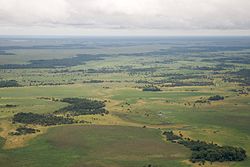- Beni savanna
-
The Beni savanna, also known as the Moxos plains, is a tropical savanna ecoregion of northern Bolivia.
Contents
Setting
The Beni savanna covers an area of 126,100 square kilometers (48,700 sq mi) in the lowlands of northern Bolivia, with small portions in neighboring Brazil and Peru. Most of the Beni savanna lies within the departments of El Beni, Cochabamba, La Paz, Pando, and Santa Cruz. The Beni savanna occupies the southwestern corner of the Amazon basin, and the region is crossed by numerous rivers that drain the eastern slope of the Andes Mountains. The low relief of the savannas, coupled with wet season rains and snowmelt from the Andes, cause up to half the land to flood seasonally.
The Beni savanna is surrounded by tropical moist forests; the Southwestern Amazonian moist forests to the north, west, and south, and the Madeira-Tapajós moist forests to the east.
Climate
The climate of the Beni savanna is tropical, with pronounced wet and dry seasons. The wet season generally extends from December to May, and annual rainfall ranges from 1300 in the east to 2000 mm in the west.
Flora
The ecoregion comprises a mosaic of savannas and wetlands, with islands of forest and gallery forests along rivers. Flooding and fire are important ecological factors.
Fauna
The Beni savanna is home to the Blue-throated Macaw (Ara glaucogularis), which is critically endangered.
People
The Beni savanna was the setting for many complex pre-Columbian societies, many of which constructed agricultural earthworks such as raised fields, causeways, canals and mounds. These earthworks were built and used from about 1 BC until about AD 1450, so far as can be told from archeological remains which do not preserve well in the tropics. The earthworks exceed the Giza pyramids in size and arouse similar speculation as to the means by which they were constructed. Prehispanic peoples made decorated pottery, wove cotton cloth, and in some places buried their dead in large urns.
A 50,000 square kilometer swath of savanna has been identified as having raised fields which were used for agriculture from about 1100 BC until AD 1450.[1]
Although Europeans arrived in the Americas in the late 15th century, they did not come to settle in the Beni savanna until the late 17th century. The missions established by Jesuit missionaries in the 17th and 18th centuries became many of the modern towns in the region.
Since the 1950s, ranching has become the most important form of agriculture, and ranches dominate the landscape.
Conservation and threats
Blue-throated Macaw - critically endangered
Sources and external links
References
- ^ Mann, Charles C. (2008-09-29). "Ancient Earthmovers of the Amazon". Science (American Association for the Advancement of Science) 321 (5893): 1150. doi:10.1126/science.321.5893.1148. PMID 18755950.
Categories:- Tropical and subtropical grasslands, savannas, and shrublands
- Ecoregions of Bolivia
- Ecoregions of Brazil
- Geography of Beni Department
- Grasslands of Bolivia
- Grasslands of Brazil
- Neotropic
Wikimedia Foundation. 2010.

